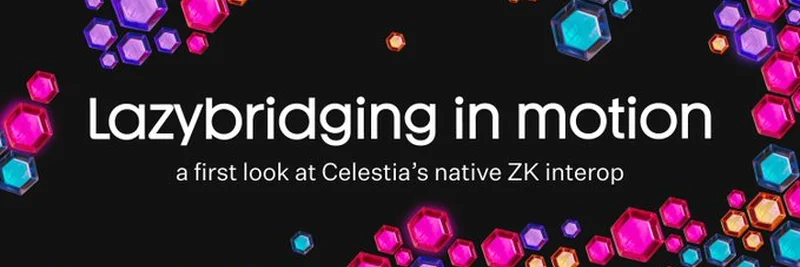Hey there, blockchain enthusiasts! If you’ve been keeping an eye on the latest trends in the crypto world, you’ve probably heard about Celestia’s exciting new development: Lazybridging. On July 29, 2025, the Celestia team dropped a teaser on X that’s got everyone buzzing. Titled “Lazybridging in Motion,” this update gives us a first look at Celestia’s native Zero-Knowledge (ZK) interop—a game-changer for how blockchains talk to each other. Let’s dive into what this means and why it’s a big deal!
What’s Lazybridging All About?
Imagine you’re sending a package across the world, but instead of relying on a middleman, you use a super-secure, math-based system to ensure it arrives safely. That’s the gist of Lazybridging! It’s a new way to connect different blockchains (called rollups) using Zero-Knowledge proofs, which are like cryptographic magic tricks that prove something is true without revealing the details. Celestia is adding this native ZK verification to its base layer, making it easier and safer for rollups to share assets and data.
In the X thread, Celestia showcased a demo where TIA (their native token) moves from Celestia’s SimApp to a ZK EVM rollup and back again. This process uses a “lock, mint, and burn” mechanism, with light clients checking ZK proofs to keep everything secure. Pretty cool, right?
Why Does This Matter?
Blockchain networks have often been like isolated islands—great on their own but tricky to connect. Lazybridging changes that by enabling trust-minimized interoperability. This means rollups can upgrade their connection to Celestia without relying on a large group of validators. Instead, they lean on cryptographic proofs, which are harder to hack and more efficient. It’s like upgrading from a flimsy rope bridge to a high-tech suspension bridge!
This move also unlocks unfragmented liquidity, a term you might see floating around. It means assets can flow more freely across different chains, making the whole ecosystem more vibrant and user-friendly. For meme token fans, this could mean easier access to cross-chain token swaps or even new meme-driven rollups built on Celestia!
What’s Next for Lazybridging?
The Celestia team isn’t stopping here. They’ve teased a public Lazybridging testnet where builders can experiment with deploying their own rollups. This testnet will offer trust-minimized access to cross-chain tokens within the Celestia ecosystem. If you’re a developer or just a curious crypto hobbyist, keep an eye out for more details—there’s a link in the thread to dive deeper (check it out here).
The Bigger Picture
Celestia is all about modular blockchain design, breaking the traditional “one-size-fits-all” approach. By adding ZK verification, they’re paving the way for a frictionless user experience where rollups can operate independently yet connect seamlessly. This aligns with the broader trend of interoperability in the blockchain space, something we’ve seen with projects like ZKsync’s Elastic Network.
For those of us at Meme Insider, this is exciting because it opens doors for meme token projects to leverage Celestia’s infrastructure. Imagine a meme token that can hop between chains with ease—talk about a viral potential!
Final Thoughts
Lazybridging in Motion is more than just a catchy title—it’s a glimpse into the future of blockchain tech. With Celestia leading the charge, we’re seeing how ZK interop can make blockchains more secure, scalable, and interconnected. Whether you’re a blockchain practitioner or just love the meme token scene, this is one development worth watching.
Stay tuned to Meme Insider for more updates, and let us know your thoughts in the comments below. Are you excited about Lazybridging, or do you have other blockchain innovations on your radar? Let’s chat!


